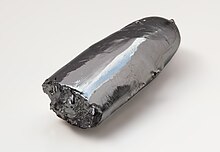Chemical element with atomic number 44 (Ru)
Ruthenium, 44 Ru Pronunciation (roo-THEE -nee-əm Appearance silvery white metallic
Atomic number (Z ) 44 Group group 8 Period period 5 Block d-block Electron configuration [Kr ] 4d7 5s1 Electrons per shell 2, 8, 18, 15, 1 Phase at STP solid Melting point 2607 K (2334 °C, 4233 °F) Boiling point 4423 K (4150 °C, 7502 °F) Density (at 20° C) 12.364 g/cm3 [ 3] when liquid (at m.p. ) 10.65 g/cm3 Heat of fusion 38.59 kJ/mol Heat of vaporization 619 kJ/mol Molar heat capacity 24.06 J/(mol·K) Vapor pressure
P (Pa)
1
10
100
1 k
10 k
100 k
at T (K)
2588
2811
3087
3424
3845
4388
Oxidation states common: +3, +4 ? [ 4] [ 4] [ 4] [ 4] [ 4] [ 4] [ 4] Electronegativity Pauling scale: 2.2 Ionization energies 1st: 710.2 kJ/mol 2nd: 1620 kJ/mol 3rd: 2747 kJ/mol Atomic radius empirical: 134 pm Covalent radius 146±7 pm Spectral lines of rutheniumNatural occurrence primordial Crystal structure hexagonal close-packed (hcp) (hP2 ) Lattice constants a = 270.58 pmc = 428.16 pm (at 20 °C)[ 3] Thermal expansion × 10−6 [ 3] [ a] Thermal conductivity 117
αa 5.77
αc 8.80
αavr 6.78 W/(m⋅K) Electrical resistivity 71 nΩ⋅m (at 0 °C) Magnetic ordering paramagnetic [ 5] Molar magnetic susceptibility × 10−6 3 /mol (298 K)[ 5] Young's modulus 447 GPa Shear modulus 173 GPa Bulk modulus 220 GPa Speed of sound thin rod 5970 m/s (at 20 °C) Poisson ratio 0.30 Mohs hardness 6.5 Brinell hardness 2160 MPa CAS Number 7440-18-8 Naming from Latin Ruthenia Russia [ 6] [ 7] Discovery and first isolationKarl Ernst Claus (1844)
Category: Ruthenium references
child table, as reused in {IB-Ru}
^ "Standard Atomic Weights: Ruthenium" . CIAAW . 1983.^ Prohaska, Thomas; Irrgeher, Johanna; Benefield, Jacqueline; Böhlke, John K.; Chesson, Lesley A.; Coplen, Tyler B.; Ding, Tiping; Dunn, Philip J. H.; Gröning, Manfred; Holden, Norman E.; Meijer, Harro A. J. (2022-05-04). "Standard atomic weights of the elements 2021 (IUPAC Technical Report)" . Pure and Applied Chemistry . doi :10.1515/pac-2019-0603 . ISSN 1365-3075 . ^ a b c d Arblaster, John W. (2018). Selected Values of the Crystallographic Properties of Elements . Materials Park, Ohio: ASM International. ISBN 978-1-62708-155-9 ^ a b c d e f g Greenwood, Norman N. ; Earnshaw, Alan (1997). Chemistry of the Elements (2nd ed.). Butterworth-Heinemann . p. 28. ISBN 978-0-08-037941-8 ^ a b Haynes, p. 4.130
^ Lewis, David E. (2019-09-02). "The Minor Impurity in Spent Ores of the "Siberian Metal": Ruthenium Turns 175" . Chemistry – A European Journal . 25 (49): 11394–11401. doi :10.1002/chem.201901922 . ISSN 0947-6539 . ^ Pitchkov, By V. N. (1996-10-01). "The Discovery of Ruthenium: "I Named The New Body, in Honour of my Motherland" . Platinum Metals Review . 40 (4): 181–188. doi :10.1595/003214096X404181188 . ISSN 0032-1400 . ^ a b Kondev, F. G.; Wang, M.; Huang, W. J.; Naimi, S.; Audi, G. (2021). "The NUBASE2020 evaluation of nuclear properties" (PDF) . Chinese Physics C . 45 (3): 030001. doi :10.1088/1674-1137/abddae . Cite error: There are <ref group=lower-alpha> tags or {{efn}} templates on this page, but the references will not show without a {{reflist|group=lower-alpha}} template or {{notelist}} template (see the help page ).

